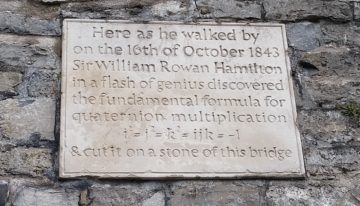by Dick Edelstein

Ireland has produced a number of prominent scientists despite being a small nation, but if you ask an average citizen about John Stewart Bell, one of the top Irish scientists of all time, you are likely to draw a quizzical look. That is mainly because the area of Bell’s important contribution, quantum mechanics, is so difficult to grasp.
Robert Boyle, on the other hand, is well known throughout the land. Boyle’s Law describes the relationship between the pressure and volume of gas molecules in a closed chamber. Tourists visiting Dublin’s Trinity College to view the Book of Kells, a spectacularly illuminated medieval bible, also see a 17th Century bust of Boyle prominently displayed in the Long Room of the Trinity College Library.
The public reputation of the 18th Century scientist and mathematician William Rowan Hamilton lies somewhere between that of these two figures. His name is fairly well known, and each year a prestigious guest lecture commemorating his work and career is given in the historic physics building in Trinity College. The importance of his work and exactly what he has accomplished in science and mathematics is less well known. As with Bell, this is partly because his most important discovery is not easy to grasp. In addition, his work was for a long time regarded as esoteric. In fact, it took over a century for his discovery of the mathematical concept of quaternions to have a significant application in technology.
Readers who can conjure up a memory of their school years may recall lessons dealing with imaginary numbers and complex numbers. The former are multiples of the difficult to imagine square root of -1, while complex numbers combine in a single term a real number component with another component that is an imaginary number. Hamilton was interested in extending the set of these complex numbers.
He knew that complex numbers could be visualized as points on a plane, and he wanted to represent these points in three-dimensional space and then perform operations on them. But although he knew how to add and subtract the coordinates used in such a representation, for a very long time he had not found a way to multiply them.
Then one day, while taking the long walk along the Royal Canal towpath from his home in the Dunsink Observatory to his workplace at Trinity College, the solution to this problem occurred to him a flash of insight. Even though he couldn’t multiply the triple coordinates, he knew how to perform this operation on quadruples. Surprisingly, the answer to his conundrum was to make use of coordinates used to represent four-dimensional space. He coined the term quaternions to denote the numbers that he used, and his system came to be called quaternion algebra. The historic moment of discovery occurred just as he was approaching the Broom bridge in the Cabra district of Dublin and, using his pocket knife, he immediately carved the fundamental equation for using quaternions into one of the stone supports of the bridge. The deceptive simplicity of this equation can be seen below:
i2 = j2 = k2 = ijk = −1
For more than a hundred years, quaternion algebra contributed hardly at all to applications in science and technology. But in the mid-20th Century, Hamilton’s work increasingly began to be used to solve problems in areas such as three-dimensional computer graphics, digital games and the control of spacecraft. Quaternions were used in the NASA Space Shuttle programme and are used today in spacecraft attitude control.
In Dublin an annual walk traces Hamilton’s route from his home to the place of his most important discovery, and tourists from around the world are regularly seen visiting the site. In 2005, the physicist Murray Gell-Man, who appropriated James Joyce’s made-up word quarks to name the fundamental particles he predicted, gave that year’s Hamilton Lecture and also joined the annual walk to Broom Bridge. The original carving of Hamilton’s equation can no longer be seen on the bridge but visitors can see a plaque bearing Hamilton’s famous equation.
Hamilton’s accomplishments help us keep in mind that purely mathematical discoveries deemed esoteric may have an eventual impact on science and technology even when it takes us a long time to discover their utility. This is important to scientists and mathematicians who undertake blue sky research driven more by scientific curiosity than short-term commercial applications, the kind of research that is imperilled in today’s science, which privileges research that holds out the promise of some immediate practical application.
Photo credit: Dick Edelstein
